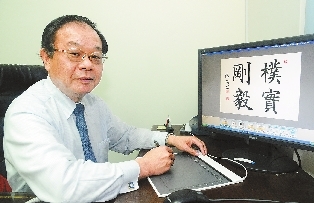
“EVERYDAY, when I go out, I bring an iPad and an Apple Pencil with me,” said Chang Ping-huang, a renowned calligrapher from Taiwan, as he introduced his new toolkit for practicing Chinese calligraphy. Chang, 69, is best known in Taiwan as host of a TV program that aired back in the 1980s where he taught the audience to write one Chinese character with ink and brush every day. The show aired for some 20 years, and Chang taught nearly 7,000 characters. With the advent of the digital era, the calligrapher and educator sought to marry modern technology with the ancient writing art. Chang has been a professor of Chinese language at Tamkang University for many years. He finds that students nowadays tend to spend much more time on computers and cell phones than with paper, and even less time on calligraphy. “It was quite a blow to me,” Chang said. “So I started to think about how to use technology to rekindle the interest in calligraphy among young people.” Starting from the very basics, Chang taught himself to use a computer and began working with the department of information engineering at Tamkang University. Six years after they began working on the initiative in 2001, they came up with a system they called “e-pen.” However, this system was not perfect. With a computer and a trackpad, the movement of the strokes could be captured, but the eyes had to focus on the screen instead of the hand. It did not feel like writing calligraphy. Thanks to the invention of the tablet computer, an updated e-pen was born. Equipped with pressure sensors, the tablet detects the tiniest details of each stroke of the stylus and visualizes it on the screen in real time. What’s even better is that people can now look at the screen and their hands at the same time. The new “e-pen” app was launched in September and soon topped Taiwan’s weekly download ranking. It also became popular on the Chinese mainland, the United States, Japan, Canada and South Korea. The e-pen app is not only for the Chinese people, but anyone with an interest in learning Chinese characters from any corner of the world, Chang said. “We did not digitalize Chinese calligraphy to make brush and ink obsolete,” Chang said, pointing to scrolls of calligraphy works hanging on the walls inside his studio in Taipei. For Chang’s own calligraphy class, he combines the traditional teaching method with modern technology. “The students’ spirits are much higher,” Chang said. To keep the tradition alive, Chang hopes more young people across the Taiwan Straits will be able to learn more about calligraphy with the help of new technologies, and maybe even fall in love with it. (Xinhua) | 
